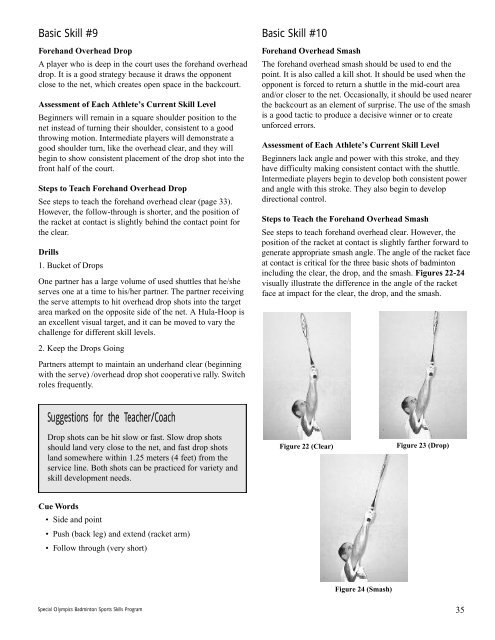BADMINTON Special Olympics Sports Skills Program
BADMINTON Special Olympics Sports Skills Program
BADMINTON Special Olympics Sports Skills Program
You also want an ePaper? Increase the reach of your titles
YUMPU automatically turns print PDFs into web optimized ePapers that Google loves.
Basic Skill #9<br />
Forehand Overhead Drop<br />
A player who is deep in the court uses the forehand overhead<br />
drop. It is a good strategy because it draws the opponent<br />
close to the net, which creates open space in the backcourt.<br />
Assessment of Each Athlete’s Current Skill Level<br />
Beginners will remain in a square shoulder position to the<br />
net instead of turning their shoulder, consistent to a good<br />
throwing motion. Intermediate players will demonstrate a<br />
good shoulder turn, like the overhead clear, and they will<br />
begin to show consistent placement of the drop shot into the<br />
front half of the court.<br />
Steps to Teach Forehand Overhead Drop<br />
See steps to teach the forehand overhead clear (page 33).<br />
However, the follow-through is shorter, and the position of<br />
the racket at contact is slightly behind the contact point for<br />
the clear.<br />
Drills<br />
1. Bucket of Drops<br />
One partner has a large volume of used shuttles that he/she<br />
serves one at a time to his/her partner. The partner receiving<br />
the serve attempts to hit overhead drop shots into the target<br />
area marked on the opposite side of the net. A Hula-Hoop is<br />
an excellent visual target, and it can be moved to vary the<br />
challenge for different skill levels.<br />
2. Keep the Drops Going<br />
Partners attempt to maintain an underhand clear (beginning<br />
with the serve) /overhead drop shot cooperative rally. Switch<br />
roles frequently.<br />
Suggestions for the Te a c h e r / C o a c h<br />
Drop shots can be hit slow or fast. Slow drop shots<br />
should land very close to the net, and fast drop shots<br />
land somewhere within 1.25 meters (4 feet) from the<br />
service line. Both shots can be practiced for variety and<br />
skill development needs.<br />
Cue Words<br />
• Side and point<br />
• Push (back leg) and extend (racket arm)<br />
• Follow through (very short)<br />
<strong>Special</strong> <strong>Olympics</strong> Badminton <strong>Sports</strong> <strong>Skills</strong> <strong>Program</strong><br />
Basic Skill #10<br />
Forehand Overhead Smash<br />
The forehand overhead smash should be used to end the<br />
point. It is also called a kill shot. It should be used when the<br />
opponent is forced to return a shuttle in the mid-court area<br />
and/or closer to the net. Occasionally, it should be used nearer<br />
the backcourt as an element of surprise. The use of the smash<br />
is a good tactic to produce a decisive winner or to create<br />
unforced err o r s .<br />
Assessment of Each Athlete’s Current Skill Level<br />
Beginners lack angle and power with this stroke, and they<br />
have difficulty making consistent contact with the shuttle.<br />
Intermediate players begin to develop both consistent power<br />
and angle with this stroke. They also begin to develop<br />
directional control.<br />
Steps to Teach the Forehand Overhead Smash<br />
See steps to teach forehand overhead clear. However, the<br />
position of the racket at contact is slightly farther forward to<br />
generate appropriate smash angle. The angle of the racket fa c e<br />
at contact is critical for the three basic shots of badminton<br />
including the clear, the drop, and the smash. Figures 22-24<br />
visually illustrate the difference in the angle of the racket<br />
face at impact for the clear, the drop, and the smash.<br />
Figure 22 (Clear)<br />
Figure 24 (Smash)<br />
Figure 23 (Drop)<br />
3 5

















